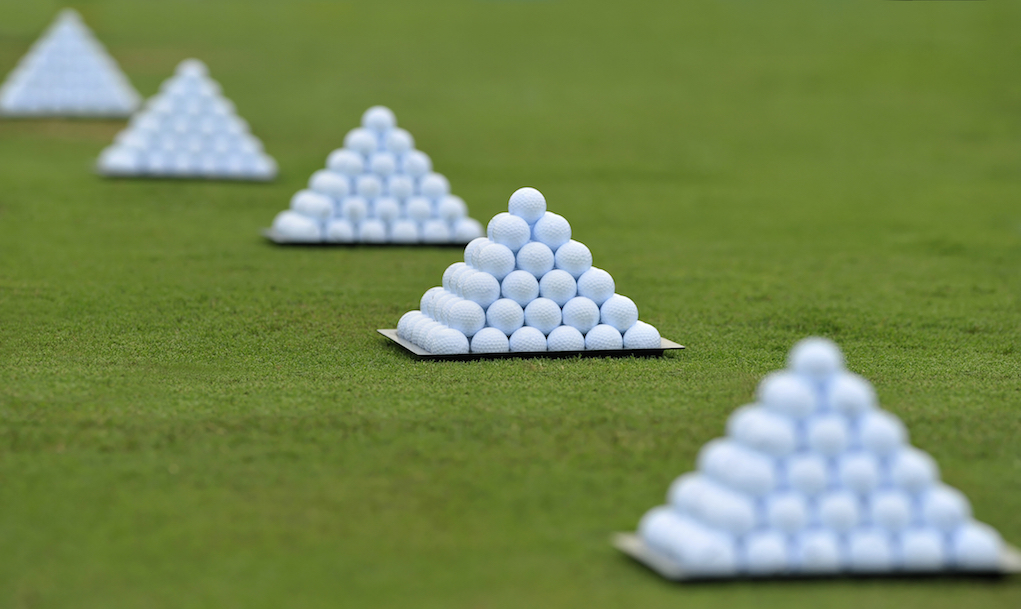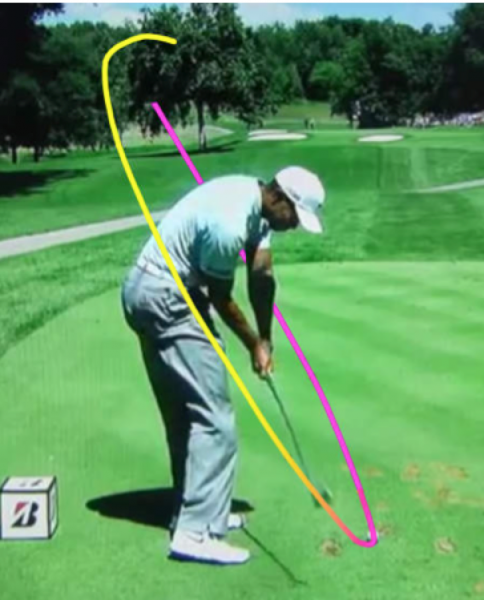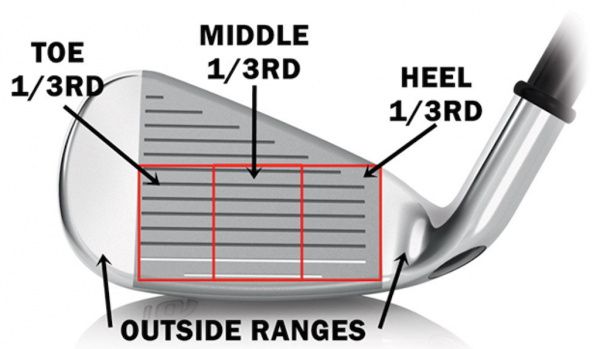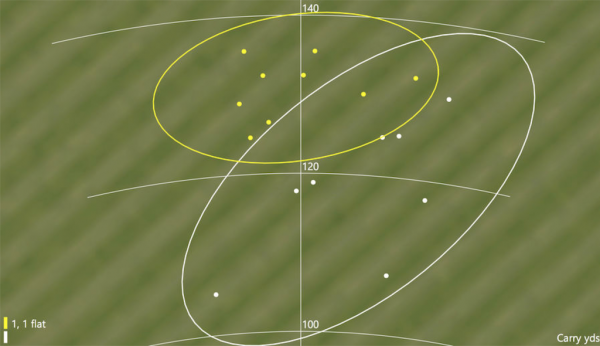Instruction
How to actually get better at golf in 2016

The New Year is here, and you want to make 2016 the best golfing year of your life, right? But it’s cold, the course is closed and you are confined to the range for the next few months.
How can you make the best of these next few months and transition your game from the range to the course when the season begins? How do you peak your performance for those important tournaments you wanted to win?
I have dedicated a vast majority of my career to designing and creating the ultimate practice plans for golfers. My book, “The Practice Manual,” is dedicated to improving both the learning and performance of golfers. In this article, I share a part of my book called “The 5 Phases,” which deals with how you might structure your practice over the course of a session, week, or even year.
Phase 1: Technical
During this phase of your training, you are going to focus 100 percent on your technique. This could be club movement/body movement, etc. “But I already do that,” most golfers tell me. Yes, but this is going to be very different.
Most golfers half-heartedly focus on a mix of technical changes and hitting good golf shots, and they usually end up getting neither. Technical changes are tough to do, as evidenced by the number of golfers who struggle to make the movements they intend to make. But this process can be much more difficult when a golfer’s attention is split between making a swing change and creating good results.
So, during this phase, make it your goal, and place 100 percent of your attention on making the desired technique. This means that the shot result becomes temporarily unimportant. Sure, we always want to hit good shots, but if you want to hit shots better than you normally do something’s gotta change. And that change might mean you hit it worse for a little while, at least until your body figures out how to put all the other pieces to the puzzle together.
Phase 2: Experimental
This is a very unorthodox phase, and 15 years ago I would have thought you were a mad man if you suggested it to me. Basically, this phase involves exploring and pushing the boundaries of your movement patterns and skills.
This will vary in intensity depending upon the current player’s skill level and comfort with this style of practice, but it may involve:
- Exploring shaping shots
- Trying to hit the sweet spot with varying set-up positions (aligning the ball on the toe or heel, for example)
- Intentionally trying to hit “wrong” parts of the clubface. As my study showed, it improved golfers quicker than the standard way.
- Exploring the scale of certain technical elements, such as hitting a few shots with a weaker grip or stronger grip.
This type of practice is skill/coordination building, and while many good golfers shy away from this type of practice due to a fear that they might “ruin” their swing, nothing could be further from the truth. Exploring different movement patterns, in the long term, can not only make golfers better, but it can improve their self-correcting capabilities, which is a vital skill to have on the course when things inevitably go wrong.
As an example, through learning to slice and fade the ball on the range, I now have the ability to fix my hook, should it occur on the course. Even though I may never use a fade shot on the course (I play a predominant draw shot), learning it helped other areas of my game.
Phase 3: Calibration
Phases 1 and 2 can be great for pushing a golfer’s potential, but they can also be quite disruptive to performance (just ask anyone going through a swing change). So when it gets closer to the golf season starting, I get more of my players to use what we call “calibration.”
During this phase, golfers focus more of their efforts on the performance of the shot, with specific analysis to the main contributing impact factors. For example, when they make a mistake, I asked them to define what kind of mistake it was. Was it:
- Ground contact?
- Clubface contact?
- Face-to-path?
- Speed (short game)?
When players see a pattern of faults occurring (through specific analysis), they then go into a training mode where they put their full attention on that specific problem. For example, if face strike was an issue, the player would then go through specific drills to improve that element before repeating the entire process.
Phase 4: Performance Training
This is a concept I devised after doing several studies with golfers and seeing varying results with players across the board. This led me to believe that everyone is different, and what works for one may not work for another. So, with this quandary in mind, how do we find out what is best for us?
This is a topic I will go over in more detail in a future article, but I would like to give a primer here. A/B testing (performance training) is where you look at two different protocols, test them both and see which one performed the best. It is such a beautifully simply idea, yet few golfers actually do it.
For example, should you focus on the target, or should you focus on your swing? While science as a whole may take the external option (target), I have seen other players actually perform better with a swing focus or swing key. If you hit 100 balls to a target and get a better dispersion while thinking about your swing than you do while thinking about the target, that information is very valuable.
In the example above, the clear-cut winner was the swing thought that produced the yellow shot grouping. I like to use Trackman data to back up this process. I can see statistically which swing thought may be functioning better for a golfer at any one time, but there are also ways that golfers can test this for themselves without launch monitor data.
Phase 5: Transference
How many golfers struggle to take their hard work from the range to the course?
Transference training is about creating situations that simulate a course scenario better than normal practice. This is often in the form of a game, such as playing the course mentally while on the range. You could also try this game below:
- Hit a drive between two markers 25 yards wide.
- If successful, hit a 7 iron between two markers 20-25 yards wide.
- If successful, hit a 60-yard pitch and stop it within a 20-foot circle of the flag.
- If successful, give yourself a point. Repeat to see how many points you can make with 60 balls. If you fail one level, start from the beginning.
This changes your mindset into a performance one, and also adds an element of pressure. It also allows you to test your ability to maintain the focus you identified in the previous phase (performance training) to see if it holds up under game-like pressure.
It also uses elements of random practice (hitting to different targets with different clubs) as opposed to blocked practice (hitting the same club to the same target over and over). The former has been shown to improve ability to transfer to the course much better.
Summary
Ideally, during the winter months, you may spend more time working in Phases 1 or 2. When spring comes around, you might transition to spend more time in Phase 3. And when time for performance has arrived, Phases 4 and 5 should dominate your sessions. Some plans I create for Tour players may include a little bit of each phase in each day, but most of my players will know what they will be doing for the full year ahead.
You can find out more about these training philosophies and much more in his amazon bestselling book “The Practice Manual – The Ultimate Guide for Golfers.” Buy it on Amazon.
- LIKE325
- LEGIT51
- WOW26
- LOL138
- IDHT3
- FLOP168
- OB149
- SHANK214
Instruction
Clement: Laid-off or perfect fade? Across-the-line or perfect draw?

Some call the image on the left laid off, but if you are hitting a fade, this could be a perfect backswing for it! Same for across the line for a draw! Stop racking your brain with perceived mistakes and simply match backswing to shot shape!
- LIKE0
- LEGIT0
- WOW0
- LOL0
- IDHT0
- FLOP0
- OB0
- SHANK1
Instruction
The Wedge Guy: The easiest-to-learn golf basic

My golf learning began with this simple fact – if you don’t have a fundamentally sound hold on the golf club, it is practically impossible for your body to execute a fundamentally sound golf swing. I’m still a big believer that the golf swing is much easier to execute if you begin with the proper hold on the club.
As you might imagine, I come into contact with hundreds of golfers of all skill levels. And it is very rare to see a good player with a bad hold on the golf club. There are some exceptions, for sure, but they are very few and very far between, and they typically have beat so many balls with their poor grip that they’ve found a way to work around it.
The reality of biophysics is that the body moves only in certain ways – and the particulars of the way you hold the golf club can totally prevent a sound swing motion that allows the club to release properly through the impact zone. The wonderful thing is that anyone can learn how to put a fundamentally sound hold on the golf club, and you can practice it anywhere your hands are not otherwise engaged, like watching TV or just sitting and relaxing.
Whether you prefer an overlap, interlock or full-finger (not baseball!) grip on the club, the same fundamentals apply. Here are the major grip faults I see most often, in the order of the frequency:
Mis-aligned hands
By this I mean that the palms of the two hands are not parallel to each other. Too many golfers have a weak left hand and strong right, or vice versa. The easiest way to learn how to hold the club with your palms aligned properly is to grip a plain wooden ruler or yardstick. It forces the hands to align properly and shows you how that feels. If you grip and re-grip a yardstick several times, then grip a club, you’ll see that the learning curve is almost immediate.
The position of the grip in the upper/left hand
I also observe many golfers who have the butt of the grip too far into the heel pad of the upper hand (the left hand for right-handed players). It’s amazing how much easier it is to release the club through the ball if even 1/4-1/2″ of the butt is beyond the left heel pad. Try this yourself to see what I mean. Swing the club freely with just your left hand and notice the difference in its release from when you hold it at the end of the grip, versus gripping down even a half inch.
To help you really understand how this works, go to the range and hit shots with your five-iron gripped down a full inch to make the club the same length as your seven-iron. You will probably see an amazing shot shape difference, and likely not see as much distance loss as you would expect.
Too much lower (right) hand on the club
It seems like almost all golfers of 8-10 handicap or higher have the club too far into the palm of the lower hand, because that feels “good” if you are trying to control the path of the clubhead to the ball. But the golf swing is not an effort to hit at the ball – it is a swing of the club. The proper hold on the club has the grip underneath the pad at the base of the fingers. This will likely feel “weak” to you — like you cannot control the club like that. EXACTLY. You should not be trying to control the club with your lower/master hand.
Gripping too tightly
Nearly all golfers hold the club too tightly, which tenses up the forearms and prevents a proper release of the club through impact. In order for the club to move back and through properly, you must feel that the club is controlled by the last three fingers of the upper hand, and the middle two fingers of the lower hand. If you engage your thumbs and forefingers in “holding” the club, the result will almost always be a grip that is too tight. Try this for yourself. Hold the club in your upper hand only, and squeeze firmly with just the last three fingers, with the forefinger and thumb off the club entirely. You have good control, but your forearms are not tense. Then begin to squeeze down with your thumb and forefinger and observe the tensing of the entire forearm. This is the way we are made, so the key to preventing tenseness in the arms is to hold the club very lightly with the “pinchers” — the thumbs and forefingers.
So, those are what I believe are the four fundamentals of a good grip. Anyone can learn them in their home or office very quickly. There is no easier way to improve your ball striking consistency and add distance than giving more attention to the way you hold the golf club.
More from the Wedge Guy
- The Wedge Guy: Golf mastery begins with your wedge game
- The Wedge Guy: Why golf is 20 times harder than brain surgery
- The Wedge Guy: Musings on the golf ball rollback
- LIKE88
- LEGIT15
- WOW6
- LOL1
- IDHT0
- FLOP4
- OB1
- SHANK8
Instruction
Clement: Stop ripping off your swing with this drill!

Not the dreaded headcover under the armpit drill! As if your body is defective and can’t function by itself! Have you seen how incredible the human machine is with all the incredible feats of agility all kinds of athletes are accomplishing? You think your body is so defective (the good Lord is laughing his head off at you) that it needs a headcover tucked under the armpit so you can swing like T-Rex?
- LIKE0
- LEGIT3
- WOW2
- LOL0
- IDHT0
- FLOP0
- OB0
- SHANK2
-

 19th Hole3 weeks ago
19th Hole3 weeks agoJustin Thomas on the equipment choice of Scottie Scheffler that he thinks is ‘weird’
-

 19th Hole3 weeks ago
19th Hole3 weeks ago‘Absolutely crazy’ – Major champ lays into Patrick Cantlay over his decision on final hole of RBC Heritage
-

 19th Hole2 weeks ago
19th Hole2 weeks agoLET pro gives detailed financial breakdown of first week on tour…and the net result may shock you
-

 19th Hole5 days ago
19th Hole5 days agoReport: LIV star turns down PGA Championship invite due to ‘personal commitments’
-

 19th Hole2 weeks ago
19th Hole2 weeks agoGary Player claims this is what ‘completely ruined’ Tiger Woods’ career
-

 Equipment4 days ago
Equipment4 days agoDetails on Justin Thomas’ driver switch at the Wells Fargo Championship
-

 Whats in the Bag2 weeks ago
Whats in the Bag2 weeks agoTeam McIlowry (Rory McIlroy, Shane Lowry) winning WITBs: 2024 Zurich Classic
-

 Whats in the Bag5 days ago
Whats in the Bag5 days agoKeegan Bradley WITB 2024 (May)






















Reeves
Jan 23, 2016 at 9:43 pm
To improve I just watched and tried the Graves Academy DVD on a single plane swing (Moe Norman type) messed around and felt swing was a joke, but then one day found an instructor near me that was a Graves Academy instructor, said what the heck called him and ask for a one hour lesson to just show me in person what this type swing actually looked like…never saw anyone hit so many straight shots, in just that hour he set me up right, let me change the “Moe Norman” grip a little stronger and bingo I could now see the single plane swing had some help for me and he cut more strokes off my game in one single hour lesson then other normal teachers did in years….went form an 18 to a 13 handicap in 3 months of playing and lost balls became a thing of the past……and if I can ever play 18 holes and release the club every time I think a 12 or 11 could be out there…
Jubes
Jan 21, 2016 at 5:05 pm
This is brilliant info and is what I am working on at the moment – 3 or 4 months in and I am still at the ignore the result phase!
I have been a low single marker my whole life but became too frustrated with my swing flaws to continue with the old 30 minute lesson model.
I’m expecting it to take at least a year given current progress but at least I am finally seeing things start to move on the correct plane.
CW
Jan 21, 2016 at 10:02 am
I read this fast but was there any explicit mention of taking lessons?
Other Paul
Jan 21, 2016 at 1:42 am
What helped me last winter
1:read KelvinMiyahira.com. articles
2: spend 3-4 hours per week working on changes hitting into a net
3: play virtual golf when its -30
4: hook the golf ball off the planet all summer
5:figured out the last swing component and hit it long and straight.
2016: just playing virtual golf
Fahgdat
Jan 21, 2016 at 3:20 am
You must be fat.
dk
Jan 21, 2016 at 1:03 am
very good stuff here
Carlos Danger
Jan 20, 2016 at 9:32 pm
BUY NEW STUFF, BUY NEW STUFF, BUY NEW STUFF, BUY NEW STUFF, BUY NEW STUFF!!!
Eric Cogorno
Jan 20, 2016 at 6:26 pm
Very well done!
Pumper
Jan 20, 2016 at 3:43 pm
Video is so important, what you think you are doing and what you are actually doing are often worlds apart. There was a good article here not long ago by Scott Hamilton on how to video your swing correctly.
Jubes
Jan 21, 2016 at 5:09 pm
Completely true! Video is absolutely essential. I believe that easy access to video is the the main reason there are not so many funky swings on tour anymore.
west
Jan 20, 2016 at 2:20 pm
So…practice?
AaronK
Jan 20, 2016 at 1:55 pm
Trying to hit the inner 1/3 of the clubface as a practice drill scares the hell out of me!
Chris
Jan 20, 2016 at 1:50 pm
Good stuff.
Barry
Jan 20, 2016 at 11:33 am
I don’t want to get better I just want to buy a bunch of new clubs:-P
Bruce
Jan 20, 2016 at 11:20 am
I always look forward to reading Adam’s articles and this is another good one.
Andy
Jan 20, 2016 at 10:42 am
Is this sponsored content? If so please mark it as so.
ooffa
Jan 20, 2016 at 10:30 am
Obvious stuff. Sheesh!
Willy
Jan 20, 2016 at 12:40 pm
Well what were you thinking he would talk about? Some quick fix?